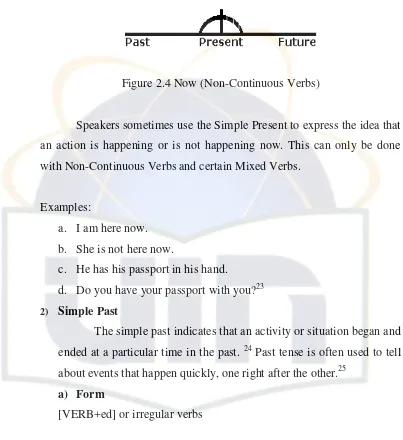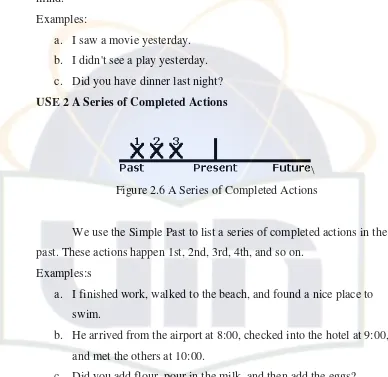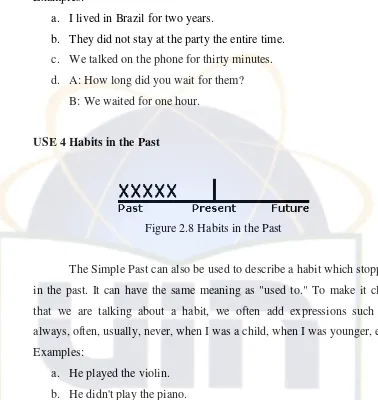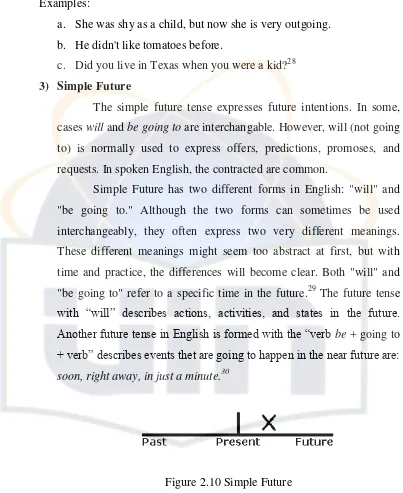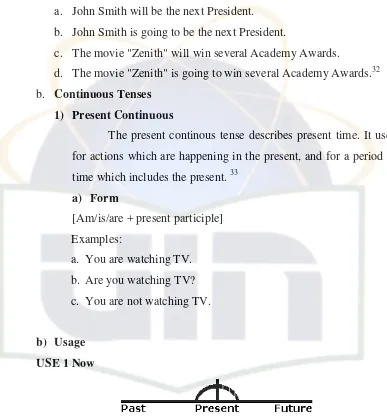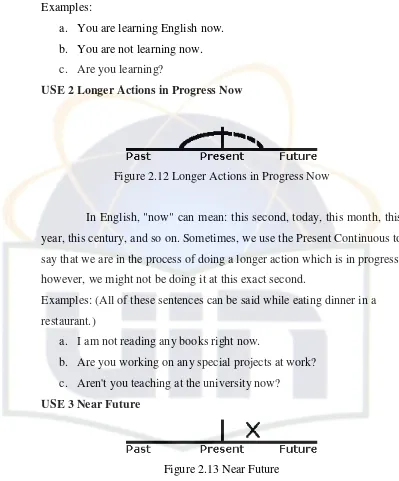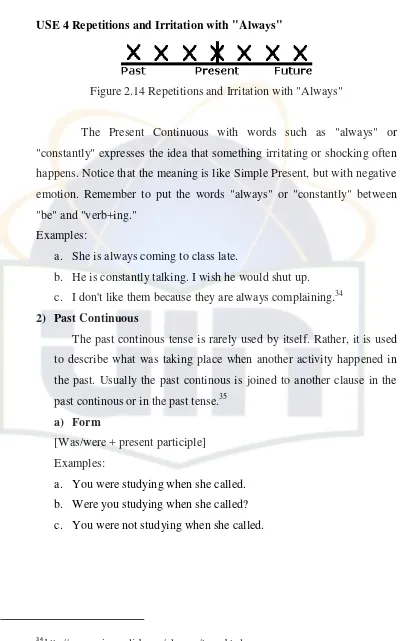A “Skripsi”
Presented to Faculty of Tarbiya and Teacher‟s Training in Partial Fulfillment of Requirements for the Degree of S.Pd (Bachelor of Arts)
in English Education Department
By:
RIZKI FAUZIAH NIM: 105014000359
DEPARTMENT OF ENGLISH EDUCATION FACULTY OF TARBIYA AND TEACHERS’ TRAINING SYARIF HIDAYATULLAH STATE ISLAMIC UNIVERSITY
A “Skripsi”
Presented to Faculty of Tarbiya and Teacher‟s Training in Partial Fulfillment of Requirements for the Degree of S.Pd (Bachelor of Arts)
in English Education Department
Approved by the Advisor;
Drs. Syauki, M. Pd NIP: 1964121219911031002
DEPARTMENT OF ENGLISH EDUCATION FACULTY OF TARBIYA AND TEACHERS’ TRAINING SYARIF HIDAYATULLAH STATE ISLAMIC UNIVERSITY
Students of MAN Cikarang, Bekasi)”, written by Rizki Fauziah, student‟s registration
number 105014000359, was examined in the examination session of Faculty of Tarbiya and Teachers‟ Training, Syarif Hidayatullah State Islamic University Jakarta on March 31st, 2011. The “Skripsi” has been accepted and declared to have fulfilled one of the requirements for the Degree of S.Pd (Bachelor of Arts) in English
Education Department.
Jakarta, March 31st, 2011
The Examination Committee
Chairman : Drs. Syauki, M. Pd (……….)
NIP: 1964121219911031002
Secretary : Neneng Sunengsih, S.Pd (……….)
NIP: 150 293 236
Examiner I : Drs. Bahrul Hasibuan, M. Ed (……….)
Examiner II : Dr. Fahriany, M. Pd (……….)
NIP: 197006111991012001
Acknowledgment by
Dean of Faculty of Tarbiya and Teachers‟ Training
guidance and everything. Then, peace and blessing be upon our prophet Muhammad
SAW, may we always be in straight way until the end of the world.
Concerning the process of writing this paper, the writer is so grateful to her
advisor, Drs. Syauki, M. Pd, for his guidance, suggestions, corrections, and valuable
help during the writing of this paper.
The writer also would like to express the deepest gratitude to those who helped the writer finishing this “Skripsi”, namely:
1. Her sweetest family; her father Mr. Sunadi, her mother Mrs. Juwayriah, her
brother Ahmad Fahrurroji, and her sister Arini Alfa Hasanah for giving the
spiritual support during the study and the process of writing this “Skripsi”.
2. All nice lecturers of English Education Department for their guidance to the
writer during her study at UIN Syarif Hidayatullah Jakarta.
3. Prof. Dr. Dede Rosada, M A, the dean of Faculty of Tarbiya and Teachers‟
Training.
4. All teachers and students of MAN Cikarang, for giving permission and
helping the writer to do the research.
5. Ka‟ Rafi, for guiding and supporting the writer to finish this “Skripsi”. Thanks
a lot for your love.
6. All her friends in English Education Department especially B Class ‟05
community. Bakti, thanks for your laptop and printer. Her inspiring friends Yayah, Ucha, Itha, Nitha, and the Cordova‟s crew for sharing and being best friend.
7. Anyone whose name can not be mentioned one by one for their contribution to the writer in finishing this “Skripsi”.
May Allah, the almighty bless them all, so be it.
Finally, the writer realizes that this “Skripsi” is still far from being perfect. Any positive or constructive comments are welcome.
A “Skripsi”
Presented to Faculty of Tarbiya and Teacher‟s Training in a Partial Fulfillment of Requirements for the Degree of S.Pd (Bachelor of Arts)
in English Education Department
By:
RIZKI FAUZIAH NIM: 105014000359
DEPARTMENT OF ENGLISH EDUCATION FACULTY OF TARBIYA AND TEACHERS TRAINING SYARIF HIDAYATULLAH STATE ISLAMIC UNIVERSITY
A “Skripsi”
Presented to Faculty of Tarbiya and Teacher‟s Training in Partial Fulfillment of Requirements for the Degree of S.Pd (Bachelor of Arts)
in English Education Department
Approved by the Advisor;
Drs. Syauki, M. Pd NIP: 19641212 1991103 1 002
DEPARTMENT OF ENGLISH EDUCATION FACULTY OF TARBIYA AND TEACHERS TRAINING SYARIF HIDAYATULLAH STATE ISLAMIC UNIVERSITY
Students of MAN Cikarang, Bekasi)”, written by Rizki Fauziah, student‟s registration
number 105014000359, was examined in the examination session of Faculty of Tarbiya and Teachers‟ Training, Syarif Hidayatullah State Islamic University Jakarta on March 31st, 2011. The “Skripsi” has been accepted and declared to have fulfilled one of the requirements for the Degree of S.Pd (Bachelor of Arts) in English
Education Department.
Jakarta, March 31st, 2011
The Examination Committee
Chairman : Drs. Syauki, M. Pd (……….)
NIP: 19641212 199103 1 002
Secretary : Neneng Sunengsih, S.Pd (……….)
NIP: 19730625 199903 2 001
Examiner I : Dr. Fahriany, M. Pd (……….)
NIP: 19700611 199101 2 001
Examiner II : Drs. Bahrul Hasibuan, M. Ed (……….)
Acknowledged by
Dean of Faculty of Tarbiya and Teachers‟ Training
Prof. Dr. Dede Rosyada, M.A
guidance and everything. Then, peace and blessing be upon our prophet Muhammad
SAW, may we always be in straight way until the end of the world.
Concerning the process of writing this paper, the writer is so grateful to her
advisor, Drs. Syauki, M. Pd, for his guidance, suggestions, corrections, and valuable
help during the writing of this paper.
The writer also would like to express the deepest gratitude to those who helped the writer finishing this “Skripsi”, namely:
1. Her sweetest family; her father Mr. Sunadi, her mother Mrs. Juwayriah, her
brother Ahmad Fahrurroji, and her sister Arini Alfa Hasanah for giving the
spiritual support during the study and the process of writing this “Skripsi”.
2. All nice lecturers of English Education Department for their guidance to the
writer during her study at UIN Syarif Hidayatullah Jakarta.
3. Prof. Dr. Dede Rosada, M A, the dean of Faculty of Tarbiya and Teachers‟
Training.
4. All teachers and students of MAN Cikarang, for giving permission and
helping the writer to do the research.
5. Ka‟ Rafi, for guiding and supporting the writer to finish this “Skripsi”. Thanks
a lot for your love.
6. All her friends in English Education Department especially B Class ‟05
community. Bakti, thanks for your laptop and printer. Her inspiring friends Yayah, Ucha, Itha, Nitha, and the Cordova‟s crew for sharing and being best friend.
7. Anyone whose name can not be mentioned one by one for their contribution to the writer in finishing this “Skripsi”.
May Allah, the almighty bless them all, so be it.
Finally, the writer realizes that this “Skripsi” is still far from being perfect. Any positive or constructive comments are welcome.
ABSTRAK...ii
ACKNOWLEDGEMENT...iii
TABLE OF CONTENTS...iv
LIST OF TABLES...vi
LIST OF APPENDICES...vii
LIST OF FIGURE...viii
CHAPTER I INTRODUCTION...1
A. The Background of the Study...1
B. The Statement of Problem...4
C. The Limitation and Formulation of the Study...4
D. The Objective of the Study...4
E. The Significance of the Study ...4
CHAPTER II THEORETICAL FRAMEWORK...5
A. Error Analysis...5
1. The Meaning of Error...6
2. The Classification of Error...7
3. Distinction between Mistake and Error...8
4. The Ways How to Analyze the Errors ...13
B. English Tense...12
1. The Meaning of Tense...12
2. The Kinds of Tense...13
C. Writing...40
1. The Meaning of Writing ...41
2. The Kinds of Writing...42
CHAPTER III RESEARCH METHODOLOGY...44
A. The Purpose of the Research...44
B. Place and Time of the Research...44
C. Technique of Sample taking...44
D. Research Instruments...45
B. Data Analysis...53
C. Data Interpretation...54
CHAPTER V CONCLUSION AND SUGGESTIONS...56
A. Conclusion...56
B. Suggestions...57
Cikarang, Bekasi, Skripsi, English Education Department, Faculty of Tarbiya and Teachers Training, Syarif Hidayatullah Jakarta State Islamic University, Jakarta. Advisor: Syauki, Drs. M. Pd.
Key terms : Errors - Error Analysis – Error Types Competence : Writing
This research is aimed to analyze the students‟ error in English free writing test on using the tenses. The limitation of the problem is classifying the students‟ writing errors into Pit Corder‟s error classifications, to know the highest frequency of the students‟ error type.
The object of the research is the eleventh grade students of MAN Cikarang, Bekasi. In collecting the data, the writer gives the free writing test. The writer gives the test consists of the theme “My Holiday”, and each of them have to make the paragraph at least consist of 75 words or more than that in one paragraph. Then, she gives the test to the 26 students. Survey method is used in this research. All of the data are taken in the same time and the writer also gives more attention the students‟ writing to analyze them then. Besides that the writer also used the quantitative method and descriptive analysis technique to analyze the data by using formula: P= F x100%. The data is taken from the students‟ test.
Bekasi), Skripsi, Pendidikan Bahasa Inggris, Fakultas Tarbiyah dah Keguruan, UIN Syarif Hidayatullah Jakarta.
Pembimbing: Syauki, Drs. M. Pd
Kata kunci :Error- analisa error- macam- macam error Kompetensi :Menulis
Penelitian in bertujuan untuk menganalisa kesalahan siswa dalam tes menulis bebas berbahasa Inggris. Pembatasan masalah dalam penelitian ini adalah pengklasifikasian kesalahan tulisan siswa berdasarkan pengklasifikasian yang dibuat oleh Pit Corder, untuk mengetahui frekuensi tertinggi dari tipe kesalahan siswa.
Objek penelitian ini adalah siswa kelas sebelas MAN Cikarang Bekasi. dalam mengumpulkan data, penulis memberikan tes menulis bebas berbahasa Inggris. Penulis memberikan tes yang bertema “My Holiday”, dan setiap mereka harus membuat tulisan dengan minimal 75 kata atau lebih dalam satu paragraph. Kemudian, penulis memberikan tes itu kepada 26 siswa. Metode survey digunakan dalam penelitian ini, semua data diambil dalam waktu yang sama dan dalam melakukan penelitian ini, penulis mencermati tulisan siswa untuk menganalisanya lebih lanjut. Penulis juga menggunakan metode kuantitatif dan tekhnik analisa deskriptif untuk menganalisa data dengan menggunakan rumus: P= F x 100%. Data diambil dari tes siswa.
guidance and everything. Then, peace and blessing be upon our prophet Muhammad
SAW, may we always be in straight way until the end of the world.
Concerning the process of writing this paper, the writer is so grateful to her
advisor, Drs. Syauki, M. Pd, for his guidance, suggestions, corrections, and valuable
help during the writing of this paper.
The writer also would like to express the deepest gratitude to those who helped the writer finishing this “Skripsi”, namely:
1. Her sweetest family; her father Mr. Sunadi, her mother Mrs. Juwairiah, her
brother Ahmad Fahrurroji, and her sister Arini Alfa Hasanah for giving the spiritual support during the study and the process of writing this “Skripsi”. 2. All nice lecturers of English Education Department for their guidance to the
writer during her study at UIN Syarif Hidayatullah Jakarta.
3. Prof. Dr. Dede Rosada, M A, the dean of Faculty of Tarbiya and Teachers‟
Training.
4. All teachers and students of MAN Cikarang, for giving permission and
helping the writer to do the research.
5. Ka‟ Rafi, for guiding and supporting the writer to finish this “Skripsi”. Thanks
a lot for your love.
6. All her friends in English Education Department especially B Class. Bakti,
thanks for your laptop and printer. Her inspiring friends Yayah, Ucha, Itha, Nitha, and the Cordova‟s crew for sharing and being best friend.
7. Anyone whose name cannot be mentioned one by one for their contribution to the writer in finishing this “Skripsi”.
May Allah, the almighty bless them all, so be it.
Finally, the writer realizes that this “Skripsi” is still far from being perfect. Any positive or constructive comments are welcomed.
Jakarta, April 26, 2010
Table 2.2 The Verb Have and other Verbs...15
Table 2.3 The Forms of Simple Past Tense...19
Table 2.4 The Forms of Simple Future Tense...23
Table 4.1 Students‟ Errors in Simple Present Tense...45
Table 4.2 Students‟ Errors in Present Continuous Tense...46
Table 4.3 Student‟s Errors in Simple Past Tense...47
Table 4.4 Students‟ Errors in Past Continuous Tense...51
Table 4.5 Students‟ Errors in Simple Future Tense...51
LIST OF APPENDICES
Appendix 1 Writing task (research instrument)
Appendix 2 Lembar Jawaban Siswa
Appendix 3 Silabus B. Inggris kelas XI semester 1 & 2
Appendix 4 Surat pengajuan judul skripsi
Appendix 5 Surat Bimbingan Skripsi
Appendix 6 Surat permohonan penelitian dari UIN Syarif Hidayatullah Jakarta
LIST OF FIGURE
Figure 2.1 Repeated Action (Simple Present) ...16
Figure 2.2 Facts or Generalization (Simple Present)...17
Figure 2.3 Scheduled Events in the Near Future...17
Figure 2.4 Now (Non-Continuous Verbs)...18
Figure 2.5 Completed Action in the Past...19
Figure 2.6 A Series of Completed Actions...20
Figure 2.7 Figure 2.7 Duration in Past...20
Figure 2.8 Habits in the Past...21
Figure 2.9 Past Facts or Generalizations...21
Figure 2.10 Simple Future...22
Figure 2.11 Now (Present Continous)...25
Figure 2.12 Longer Actions in Progress Now...26
Figure 2.13 Near Future...26
Figure 2.14 Repetitions and Irritation with "Always"...27
Figure 2.15 Interrupted Action in the Past...28
Figure 2.16 Specific Time as an Interruption...28
Figure 2.17 Parallel Actions...29
Figure 2.18 Repetition and Irritation with "Always"...29
Figure 2.19 Interrupted Action in the Future...30
Figure 2.20 Specific Time as an Interruption in the Future...31
Figure 2.21 Parallel Actions in the Future...31
Figure 2.22 Unspecified Time Before Now...33
Figure 2.23 Completed Action Before Something in the Past...34
Figure 2.24 Duration Before Something in the Past (Non-Continuous Verbs)...34
Figure 2.25 Duration from the Past Until Now...36
Figure 2.26 Recently, Lately...37
Figure 2.27 Duration Before Something in the Past...38
Figure 2.28 Cause of Something in the Past...39
Figure 2.29 Duration Before Something in the Future...40
1
CHAPTER I INTRODUCTION
A. The Background of the Study
English is one of the international languages that has an important
role in the world. It is widely studied and used as a tool of communication
among people all over the world. English becomes one of the important
subject matters taught at school. In Indonesia, English is considered as the
first foreign language and becomes a compulsory subject learned by all
students from the elementary school up to university.
English language teaching includes four skills such as listening,
speaking, reading and writing. One of the language skill which is very
difficult to study is writing. English writing is a subject that learns about
how to express our idea in written form. The students of elementary
school, junior high school, and senior high school in writing skill
especially learn to write words, phrases, clauses, and sentences. Then,
when the students make a sentence they should concern with: subject,
verb, and tense.
In English learning process, students sometimes make some errors
and mistakes. In science, the word "error" does not mean "mistake" or
"blunder" but rather the inevitable uncertainty of all measurements.
Because they cannot be avoided, errors in this context are not, strictly
possible, and their size can be reliably estimated.1 Errors are considered as essential things to both learners and teachers since the making errors can
be regarded as an important part of learning in order to get information.
The information indicates which part of the target language that students
have the most difficult to produce correctly. Errors also give another
benefit to teachers by showing what learners have not mastered yet in the
lesson.
According to competence based curriculum, one of the goals in
learning English is to increase communication competence in the language
that consists of listening, speaking, reading, and writing of course.2 In
other words, learning English means learn to communicate through the
target language, not only spoken but also written. As stated in English
syllabus, the goal in learning writing for eleventh grade of senior high
school is the students could understand and use the short functional texts in
their daily life.
As the writer‟s experience, when she was teaching the students of
State Islamic Senior High School (MAN) Cikarang, Bekasi, she found the most of students made errors in using the tenses. That is why the writer tries to analyze the students‟ problems in using the tenses of English verb. Exactly, these problems were at eleventh grade students of State Islamic
Senior High School (MAN) Cikarang, Bekasi. Here, the writer need the students know more about the use of tenses correctly.
Tense is an aspect of language that should be learnt by the students.
Tenseis used to show the relation between the action or state described by
the verb and the time, which is reflected in the form of the verb. There are
two basic tenses in English; the present tense and the past tense. The
present is like the base form, although the third person singular adds -s.
1
http://www.usingenglish.com/ErrorAnalysis.html 2
Regular verbs add -ed or -d to show the past tense, while irregular verbs change in many different ways, or not at all in some cases.3 To make a good sentence they should master tense. Tense is difficult to study. When
they write a sentence, most of the students found some problems to
determine and to choose the appropriate tense. Tense related with
changing of verb agree with the time. There are two kinds of verb namely
regular and irregular verb. The students always make error to change the
verb in different tense because in indonesia has not irregular and regular
verb.
The English tense system is quite complicated, but the most
common problem is not how to form tenses. The mechanical manipulation
of verbs is easily learned through a few rules and formulas. The biggest
problem is deciding which tense to use in a given situation. In order to
choose correctly and easily, the student must understand the meaning of
the tense itself, its time picture or time line. He must know what kinds of
activities and states can be described by certain verbs. And this can present
problems, too. Finally, the students need to be able to choose accurate time
markers to clarify the time picture.
According to the writer, the students made errors of using tense
because three reasons. First, that english has great variety of tense, is one
of reason why the indonesian students have difficulties in understanding
tenses. The second reason is that Indonesian students are influenced by
their mother tongue. The last reason is in indonesia there is no subject-verb
agreement. The students make a sentence without concern with
subject-verb agreement.
3
From the description above, the writer is interested in doing research about “An Analysis of Students Error in English free Writing Focused on the Use of Tenses”.
B. The Statement of the Problem
Based on the background of the study described above, the writer is
interested in analyzing the errors done by the eleventh grade students of
Madrasah Aliyah Negeri (MAN) Cikarang in English free writing focused on the use of tenses.
These errors are taken from the test. The writer would like to formulate the problem as follow: “what kinds of tenses errors do the eleventh grade students of MAN Cikarang in English free writing?
C. The Limitation and the Formulation of the Study
The writer limits her study on the errors done by eleventh grade
students of MAN Cikarang on English Writing. These errors are taken from the test that focused on the tenses. Tenses they have learned, there
are: (Simple Tenses); Simple Present, Simple Past, Simple Future.
(Continous Tenses); Present Continous, Past Continous, Future Continous. (Perfect Tenses); Present Perfect, Past Perfect, Future Perfect.
(Perfect Continous Tenses); Present Perfect Continous, Past Perfect Continous, Future Perfect Continous.
D. The Objective of the Study
The objective of the study is to find out the students‟ free writing
errors focused on the use of Tenses by eleventh grade students of MAN Cikarang, Bekasi. Then, the writer analyzes the same errors to the students as well.
E. The Significance of the study
This study is intended for the improvement of the students and
teachers in learning and teaching English based on the analysis of errors
made by students on English writing test. The writer hopes that this study
will be useful for both teachers and students to study harder in order to
5 CHAPTER II
THEORETICAL FRAMEWORK
A. Error analysis
In language learning process, any student attempting to avoid
making errors is impossible. It is very natural for him or her to make errors
in this process. Even the students will get feedbacks that will make them
selves become better students in writing through the errors that they make.
In other words, to achieve English acquisition, the students must get
through some errors first, and then automatically they can learn from their
own errors. And before knowing more about error analysis, it is good to
understand the definition of error analysis.
Error analysis is a process based on analysis of learner‟s error in their process of second language learning. Sharma wrote on his article “Error analysis is defined as a process based on analysis of learner‟s with one clear objective, evolving a suitable and effective teaching learning
strategy and remedial measures neccessary in certain clearly marked out
areas of the foreign language”. 1
Errors have an important role in the study of language the learner‟s
who made errors; automatically they can learn from their own errors and
develop the language. Lengo says, “errors are believed to be an indicator
1
of the learners‟ stages in their target language development from the errors that learners commit, one can determine their level of mastery of the
language system”. 2
According to the definitions above, error analysis can be said as an effort to get data about the students‟ difficulty in learning a language, especially in writing; then she tries to do analyze the data to know more
detail about the problems faced by the students and solve the problems by
making improvement in teaching and learning language.
1. The Meaning of Error
Errors are noticeable and cannot be self-corrected, they are
deviation from the adult grammar of a native speaker, and the portion
of the learners competence in the target language. 3
Dulay stated, “Error is the flawed side of learner speech or writing”. It means that there is something wrong in norm of language performance.4 Then Brown said, “put in other way, an error is a noticeable deviation from the adult grammar of a native speaker,
reflecting the interlanguage competence of the learner”. 5
Harmer said that the errors are part of the learner inter language
that is the version of the language which a learner has any one stage of
development and which is continually reshaped as he/she aims toward
full mastery. 6
From the definitions above, the writer summarizes that error is
a part of second language acquisition that happens systematically and consistently learners do that and it‟s caused by lack of comprehending the linguistic competence. On the other hand, making errors are part of
2
Nsakala Lengo, What is an error? English Teaching Forum (July,1995 Vol 33), p.20 3
H. Douglas Brown, Principle of Language Learning and Teaching ... p. 205
4
Heidy Dulay, et. Al, Language Two (New York: Oxford University Press 1985), p.138 5
H. Douglas Brown, Principle of Language Learning and Teaching ... p. 217 6
learning process and no one can learn language without his/her first
making errors.
2. The Classification of Error
According to Corder, errors fall into four main categories:
Omission of same required element, addition of unnecessary or
incorrect element, selection of an incorrect element and misordering of
element. 7
a. Omission
Certain linguistic forms may be omitted by the learner
because of their complexity in production. Omission also occurs in
Morphology, learners often leave out the third person singular
morpheme –s, the plural marker-s and the past tense inflection –ed. For example: “a strange thing happen to me yesterday”. Instead of : “a strange thing happened to me yesterday”.
b. Addition
Learners not only commit elements which they regard as
redundant but they also add redundant element. For example:
1) I thinks
2) The books is here
c. Selection
Learners commit errors in pronunciation, morphology,
syntax, and vocabulary, due to the selection of the wrong phoneme,
structure vocabulary item. For example: “My friend is oldest than me”. Instead of: “My friend is older than me”.
7
d. Ordering
Misordering can occur in morphological level misordering of
bound morpheme in English is perhaps less frequent, given their limited number; but in the example “he is get upping now”, the learners attaches the inflection-ing to the two words verb “get up”.8
3. Distinction between Mistake and Error
Most of people misunderstand about errors and mistakes; they
think they are in the same meaning. So we need to distinguish errors and mistakes. Errors reflect gaps in a learner‟s knowledge; they occur because the learner does not know what is correct. Mistakes reflect
occasional lapses in performance; they occur because, in particular
instance, the learner is unable to perform what he or she knows.
In other words, error is a lack of knowledge and mistake is
the students possess knowledge of the correct form and are just
slipping up.9
Brown (2000: 217) also gives the similar opinion about error
and mistake. According to him, an error is a noticeable deviation from
the adult grammar of a native speaker, reflects the competence of the learner. And a mistake is a “slip,” a failure to utilize a known system correctly, and mistakes can be self-corrected.10
Then the writer concludes that students make error because
they do not know of the knowledge about what they write, and they
can not recognize it unless other people, their friends or their teachers
tell and correct them. And for mistake, actually the students have known about what they write but they just „slip up‟ and do mistakes. In this case, students are able to correct and realize their own mistake.
8
Nsakala Lengo, What is an Error?English Teaching Forum ... pp. 22-24
9
Rod Ellis, Second Language Acquisition, (New York: Oxford University Press, 2003), p. 17
10
4. The Cause of Error
Examining error analysis procedures used to identify errors in
second written language learner is determining the source of error.
According to Brown (2000: 223- 227), there are three sources of error:
inter-lingual transfer, intra-lingual transfer, and context of learning. More
specific about the sources are in the following passages.11
First, inter-lingual transfer, in this term, before the system of the
second language is familiar for the learners; the mother tongue is the only
previous linguistic system upon which the students can draw. Indonesian students tend to write “She eat an apple,” than “She eats an apple,” and other example, “I have three book,” instead of “I have three books.” All of these errors are caused by negative inter-lingual transfer. While it is
not always clear that an error is the result of the native language transfer,
many such errors are detectable in learner speech. Fluent knowledge or
even familiarity with a learner‟s native language of course aids the
teacher in detecting and analyzing such errors.
Next, intra-lingual transfer (within the target language itself), is a
major factor in second language learning. Negative intra-lingual transfer
then produces overgeneralization. The students habitually are not sure of
what they want to express in their writing, which would cause them to
make errors in any language. Negative intra-lingual transfer or
overgeneralization can be showed through the sentence that students of second language learning make, “does the boy can not run?” and “he eated fried rice.”
And the last is context of learning. “Context” refers, for example, to the classroom with its teacher and its materials in the case of school
learning or the social situation in the case of untutored second language
learning. In a classroom context the teacher or the textbook can lead the
learner to make faulty hypotheses about the language. Students often
11
make errors because of a misleading explanation from the teacher, faulty
presentation of a structure or a word in a textbook, or even because of a
pattern that was rarely memorized in a drill but improperly
contextualized. Two vocabulary items presented contiguously- e.g. look
up and look at- might in later recall be confused simply because of the
contiguity of presentation. Or a teacher may provide incorrect
information- not an uncommon occurrence- by way of a misleading
definition, word, or grammatical generalization. Another manifestation of
language learned in classroom contexts is the occasional tendency on the
part of learners to give unconstructed and inappropriately formal forms of language. We have all experienced foreign learners whose “bookish” language gives them away as classroom language learners.
Based on Pit Corder (in Hubbard, 1983), there are three major causes of errors, which he labels „transfer errors‟, „analogical errors,‟ and „teaching-induced errors‟.
a. Transfer Errors
The beginning stages of learning a second language are characterized by a predominance of interference of learner‟s native language. In this early stages, before the system of the second language is a
familiar, the native language is only linguistic system in previous
experience upon which the learner can draw.
b. Analogical errors
Although when the learners have discovered a correct rule of the target
language, they may still continue to make errors, because they have
not discovered yet the precise set of categories to which the rule
applies. Errors which result from this strategy are called analogical
errors.
c. Teaching Induced Errors
Errors in second language learning may appear to be induced by the
used by the teachers can lead learners to make faulty hypothesis
about the language.
While Hubbard proposed slightly different names: 12
a. Mother-tongue interference
Although young children appear to be able to learn a foreign
language quite easily and to reproduce new sound very
effectively, older learners experience considerable difficulty.
The sound system (phonology) and the grammar of the first
language impose themselves on the new language and this lead to a “foreign” pronunciation, faulty grammatical patterns and, occasionally, to the wrong choice of vocabulary.
b. Overgeneralization
The mentalist theory claims that errors are inevitable because
they reflect various stages in the language development of the
learner. It claims that the learner processes new language data
in his mind and produces rules for its production, based on the
evidence. Where the data are inadequate, or the evidence only
partial, such rules may produce incorrect pattern.
c. Context of learning
A third major source of error, through is overlaps both types of
transfer, is the context of learning. “Context” refers to the
classroom with the teacher and the material in the case of
school learning or the social situation. In a classroom context,
the teacher or the textbook can lead the learner to make faulty
hypothesis about the language what Richards called “False concept” and what Stenson termed “Induced errors.” Students often make errors because of a misleading explanation from
the teacher, faulty presentation of a structure or word in the
12
textbook, or even because of a pattern, that was rote
memorized in a drill but not properly contextualized.
5. The Ways How to Analyze the Errors
One of the common difficulties in understanding the linguistic
system of both first and second language learners is the fact that such
system cannot be directly observed.13 Sridhar arranges the steps in error analysis as follow:
1. Collection of data (either from a „free‟ composition by students on
s given theme or from examanation answers ).
2. Identification of errors
3. Classification into error types (e.g. errors of agreement, articles,
verb forms, etc).
4. Statement of relative frequency of error types.
5. Identification of the areas of difficulty in the target language.
6. Therapy (remedial drills, lesson, etc).14
B. English Tense
1. The Meaning of Tense
Tense means time, however, it should be pointed out that time in
relation to action is a concept that exist in the mind of the speaker,
reader, or listener. Tense, in actual usage, refers consistently only to
grammatical forms. Often tense and time do not correspond at all. 15 The word “Tense” derived ultimatelly from the Latin word “Tempus” meaning “Time”. 16
Tense commonly refers to the time of
the situation which relates to the situation of the utterance or at the
moment of speaking. For example, the commonest tense found in the
13
H. Douglas Brown, Principle of language learning and teaching ... pp. 207-208
14
Jacek Fisiak, Contrastive Linguistics and Language Teacher: Contrastive Analysis, Error analysis. (Pergamon Press Ltd, 1981), p.222
15
George E.Wishon and Julia M.Burks, Let’s Write English. (American Book Company Litton Educational Publishing, inc.1980), p. 192 Revised Edition
16
languages are present, past and future; a situation described in the
present, past and future; a situation described in the present tense is
related as simultaneous with the moment of speaking (John is singing);
the situation described in the past as related prior to the moment of
speaking (Jhon was singing); while the situation described the future as
relates subsequent to the moment of speaking (Jhon will sing) since
tense refers to the time of the situation which relates to the situation of
the utterance or to relate the content of the message to the speaker in items of the “Here and Now”, it can be described as “deictic”.17
2. The Kinds of Tenses
a. Simple Tenses 1) Simple Present
The simple Present tense known as “The Historical Present”. It uses the present tense to relate a past event and is very common in
oral narrative.18
The present tense shows clearly that in English, tense is not the
same time. The present tense is not usually used to describe present
time. Instead, it describes activities and states which are generally
and universally true. The present tense is the tense for description,
definition, and statements of general truth.19
The simple present tense can describe habits, routines, or
events that happen regularly. It can also express opinions or make
general statement of fact.
a) Form
[VERB] + s/es in third person20
17
www.helsinki Fi/-mpalande/meaning_of_tense_and_aspect_html. 18
Marianne Celce-Murcia and Diane Larsen-Freeman, The Grammar Book (An ESL/EFL
Teacher’s Course). (Heinle and Heinle Publisher, 1999), p.166, Second Edition.
19
Patricia Wilcox Peterson, Changing Times Changing Tenses. (Washington: United States Information Agency, 1985) p. 10
20
Table 2.1 The Verb Be
No Forms Affirmative
Statement
Negative Statement
1. Long Forms I am a student
She is at the college
We are in the library
I am not a teacher
He is not at the
college
They are not in the
library
2. Contracted form I‟m here
She‟s here
We‟re in the library
I‟m not there He isn‟t there
They aren‟t in the library
Table 2.2
The Verb Have and Other Verbs
No Forms Affirmative
Statement
Negative Statement
1. Long forms I have class every day
I study a lot
She has classes
everyday
She studies a lot
They do not have
class everyday
They do not study a
lot
He does not have
class everyday
He does not study a
lot
everyday
He doesn‟t study a lot 21
Examples:
a. You speak English.
b. Do you speak English?
c. You do not speak English.22
b) Usage
[image:31.595.109.544.114.675.2]USE 1 Repeated Action
Figure 2.1 Repeated Action (Simple Present)
Use the Simple Present to express the idea that an action is
repeated or usual. The action can be a habit, a hobby, a daily event, a
scheduled event or something that often happens. It can also be something
a person often forgets or usually does not do.
Examples:
a. I play tennis.
b. She does not play tennis.
c. Does he play tennis?
21
John P. Nelson, Interaction 2 Grammar (McGraw – Hill Contemporary, 2002), pp. 3-4
22
USE 2 Facts or Generalizations
Figure 2.2 Facts or Generalization (Simple Present)
The Simple Present can also indicate the speaker believes that a
fact was true before, is true now, and will be true in the future. It is not
important if the speaker is correct about the fact. It is also used to make
generalizations about people or things.
Examples:
a. Cats like milk.
b. Birds do not like milk.
c. Do pigs like milk?
USE 3 Scheduled Events in the Near Future
Figure 2.3Scheduled Events in the Near Future
Speakers occasionally use Simple Present to talk about scheduled
events in the near future. This is most commonly done when talking about
public transportation, but it can be used with other scheduled events as
well.
Examples:
a. The train leaves tonight at 6 PM.
b. The bus does not arrive at 11 AM, it arrives at 11 PM.
c. When do we board the plane?
d. The party starts at 8 o'clock.
USE 4 Now (Non-Continuous Verbs)
Figure 2.4 Now (Non-Continuous Verbs)
Speakers sometimes use the Simple Present to express the idea that
an action is happening or is not happening now. This can only be done
with Non-Continuous Verbs and certain Mixed Verbs.
Examples:
a. I am here now.
b. She is not here now.
c. He has his passport in his hand.
d. Do you have your passport with you?23
2) Simple Past
The simple past indicates that an activity or situation began and
ended at a particular time in the past. 24 Past tense is often used to tell about events that happen quickly, one right after the other.25
a) Form
[VERB+ed] or irregular verbs
23
http://www.usingenglish.com/glossary/tense.html 24
Betty Schramper Azar, Understanding and Using English Grammar, Third Edition (Pearson education, 1999), p. 27
25
Table 2.3
No Forms Affirmative
Statement
Negative Statement
1 Long Forms I studied for an hour
It looked yesterday.
They took math last
year
I did not study
It did not worked
yesterday
They did not take
math
2 Contracted Forms It didn‟t work
yesterday It didn‟t work yesterday They didn‟t take math 26
Examples:
a. The airplane arrived at noon
b. I received some visitors and cleaned my desk
c. I saw him three years ago 27
b) Usage
[image:34.595.111.514.117.623.2]USE 1 Completed Action in the Past
Figure 2.5Completed Action in the Past
26
John P. Nelson, Interaction 2 Grammar ... p. 20
27
Use the Simple Past to express the idea that an action started and
finished at a specific time in the past. Sometimes, the speaker may not
actually mention the specific time, but they do have one specific time in
mind.
Examples:
a. I saw a movie yesterday.
b. I didn't see a play yesterday.
c. Did you have dinner last night?
USE 2 A Series of Completed Actions
[image:35.595.113.501.184.561.2]\
Figure 2.6A Series of Completed Actions
We use the Simple Past to list a series of completed actions in the
past. These actions happen 1st, 2nd, 3rd, 4th, and so on.
Examples:s
a. I finished work, walked to the beach, and found a nice place to
swim.
b. He arrived from the airport at 8:00, checked into the hotel at 9:00,
and met the others at 10:00.
c. Did you add flour, pour in the milk, and then add the eggs?
USE 3 Duration in Past
Figure 2.7 Duration in Past
The Simple Past can be used with a duration which starts and stops
in the past. Duration is a longer action often indicated by expressions such
Examples:
a. I lived in Brazil for two years.
b. They did not stay at the party the entire time.
c. We talked on the phone for thirty minutes.
d. A: How long did you wait for them?
B: We waited for one hour.
[image:36.595.116.494.123.523.2]USE 4 Habits in the Past
Figure 2.8 Habits in the Past
The Simple Past can also be used to describe a habit which stopped
in the past. It can have the same meaning as "used to." To make it clear
that we are talking about a habit, we often add expressions such as:
always, often, usually, never, when I was a child, when I was younger, etc.
Examples:
a. He played the violin.
b. He didn't play the piano.
c. Did you play a musical instrument when you were a kid?
USE 5 Past Facts or Generalizations
Figure 2.9 Past Facts or Generalizations
The Simple Past can also be used to describe past facts or
generalizations which are no longer true. As in USE 4 above, this use of
[image:36.595.236.427.589.631.2]Examples:
a. She was shy as a child, but now she is very outgoing.
b. He didn't like tomatoes before.
c. Did you live in Texas when you were a kid?28
3) Simple Future
The simple future tense expresses future intentions. In some,
cases will and be going to are interchangable. However, will (not going to) is normally used to express offers, predictions, promoses, and
requests. In spoken English, the contracted are common.
Simple Future has two different forms in English: "will" and
"be going to." Although the two forms can sometimes be used
interchangeably, they often express two very different meanings.
These different meanings might seem too abstract at first, but with
time and practice, the differences will become clear. Both "will" and
"be going to" refer to a specific time in the future.29 The future tense with “will” describes actions, activities, and states in the future. Another future tense in English is formed with the “verb be + going to + verb” describes events thet are going to happen in the near future are:
[image:37.595.110.513.117.610.2]soon, right away, in just a minute.30
Figure 2.10Simple Future
28
http://www.usingenglish.com/glossary/tense.html
29
http://www.usingenglish.com/glossary/tense.html 30
a) Form
1. [Will + verb]
Examples:
a. You will help him later.
b. Will you help him later?
c. You will not help him later.
2. [Am/is/are + going to + verb]
Examples:
a. You are going to meet Jane tonight.
b. Are you going to meet Jane tonight?
c. You are not going to meet Jane tonight. 31
Table 2.4
31
http://www.usingenglish.com/glossary/tense.html
No Forms Affirmative
Statement
Negative Statement
1 Long Forms It will work very
well
They I will study
tonight
will take math next
term
I will not study
tonight
It will not work very
well
They will not take
math next term.
2 Contracted Forms I‟ll study tonight It‟ll take work very well
The‟ll take math next term
I won‟t study tonight It won‟t work very well
b) Usage
USE 1 "Will" to Express a Voluntary Action
"Will" often suggests that a speaker will do something voluntarily.
A voluntary action is one the speaker offers to do for someone else. Often,
we use "will" to respond to someone else's complaint or request for help.
We also use "will" when we request that someone help us or volunteer to
do something for us. Similarly, we use "will not" or "won't" when we
refuse to voluntarily do something.
Examples:
a. I will send you the information when I get it.
b. I will not do your homework for you.
c. Will you help me move this heavy table?
USE 2 "Will" to Express a Promise
"Will" is usually used in promises.
Examples:
a. I will call you when I arrive.
b. I promise I will not tell him about the surprise party.
c. Don't worry, I'll be careful.
d. I won't tell anyone you‟re secret.
USE 3 "Be going to" to express a Plan
"Be going to" expresses that something is a plan. It expresses the
idea that a person intends to do something in the future. It does not matter
whether the plan is realistic or not.
Examples:
a. He is going to spend his vacation in Hawaii.
b. She is not going to spend her vacation in Hawaii.
c. A: When are we going to meet each other tonight?
USE 4 "Will" or "Be Going to" to Express a Prediction
Both "will" and "be going to" can express the idea of a general
prediction about the future. Predictions are guesses about what might
little control over the future and therefore USES 1-3 do not apply. In the
following examples, there is no difference in meaning.
Examples:
a. John Smith will be the next President.
b. John Smith is going to be the next President.
c. The movie "Zenith" will win several Academy Awards.
d. The movie "Zenith" is going to win several Academy Awards.32 b. Continuous Tenses
1) Present Continuous
The present continous tense describes present time. It used
for actions which are happening in the present, and for a period of
time which includes the present. 33
a) Form
[Am/is/are + present participle]
Examples:
a. You are watching TV.
b. Are you watching TV?
c. You are not watching TV.
[image:40.595.113.500.171.587.2]b) Usage USE 1 Now
Figure 2.11 Now (Present Continous)
Use the Present Continuous with Normal Verbs to express the
idea that something is happening now, at this very moment. It can also be
used to show that something is not happening now.
32
http://www.usingenglish.com/glossary/tense.html
33
Examples:
a. You are learning English now.
b. You are not learning now.
c. Are you learning?
[image:41.595.108.507.113.594.2]USE 2 Longer Actions in Progress Now
Figure 2.12 Longer Actions in Progress Now
In English, "now" can mean: this second, today, this month, this
year, this century, and so on. Sometimes, we use the Present Continuous to
say that we are in the process of doing a longer action which is in progress;
however, we might not be doing it at this exact second.
Examples: (All of these sentences can be said while eating dinner in a
restaurant.)
a. I am not reading any books right now.
b. Are you working on any special projects at work?
c. Aren't you teaching at the university now?
USE 3 Near Future
Figure 2.13 Near Future
Sometimes, speakers use the Present Continuous to indicate that
something will or will not happen in the near future.
Examples:
a. I am meeting some friends after work.
b. I am not going to the party tonight.
USE 4 Repetitions and Irritation with "Always"
Figure 2.14 Repetitions and Irritation with "Always"
The Present Continuous with words such as "always" or
"constantly" expresses the idea that something irritating or shocking often
happens. Notice that the meaning is like Simple Present, but with negative
emotion. Remember to put the words "always" or "constantly" between
"be" and "verb+ing."
Examples:
a. She is always coming to class late.
b. He is constantly talking. I wish he would shut up.
c. I don't like them because they are always complaining.34
2) Past Continuous
The past continous tense is rarely used by itself. Rather, it is used
to describe what was taking place when another activity happened in
the past. Usually the past continous is joined to another clause in the
past continous or in the past tense.35
a) Form
[Was/were + present participle]
Examples:
a. You were studying when she called.
b. Were you studying when she called?
c. You were not studying when she called.
34
http://www.usingenglish.com/glossary/tense.html
35
b) Usage
[image:43.595.111.510.166.539.2]USE 1 Interrupted Action in the Past
Figure 2.15Interrupted Action in the Past
Use the Past Continuous to indicate that a longer action in the
past was interrupted. The interruption is usually a shorter action in the
Simple Past. Remember this can be a real interruption or just an
interruption in time.
Examples:
a. I was watching TV when she called.
b. When the phone rang, she was writing a letter.
c. While we were having the picnic, it started to rain.
d. What were you doing when the earthquake started?
USE 2 Specific Time as an Interruption
Figure 2.16 Specific Time as an Interruption
In USE 1, described above, the Past Continuous is interrupted by
a shorter action in the Simple Past. However, you can also use a specific
time as an interruption.
Examples:
a. Last night at 6 PM, I was eating dinner.
b. At midnight, we were still driving through the desert.
USE 3 Parallel Actions
Figure 2.17 Parallel Actions
When you use the Past Continuous with two actions in the same
sentence, it expresses the idea that both actions were happening at the
same time. The actions are parallel.
Examples:
a. I was studying while he was making dinner.
b. While Ellen was reading, Tim was watching television.
c. Were you listening while he was talking?
USE 4 Atmosphere
In English, we often use a series of parallel actions to describe
the atmosphere at a particular time in the past.
Example:
a. When I walked into the office, several people were busily typing,
some were talking on the phones, the boss was yelling directions,
and customers were waiting to be helped. One customer was
yelling at a secretary and waving his hands. Others were
complaining to each other about the bad service.
[image:44.595.111.514.137.560.2]USE 5 Repetition and Irritation with "Always"
Figure 2.18 Repetition and Irritation with "Always"
The Past Continuous with words such as "always" or "constantly"
expresses the idea that something irritating or shocking often happened in
negative emotion. Remember to put the words "always" or "constantly"
between "be" and "verb+ing."
Examples:
a. She was always coming to class late.
b. I didn't like them because they were always complaining.
3) Future Continuous
The future continous is generally used to set up background
activity that is in progress when another action takes place.36 Future Continuous has two different forms: "will be doing " and "be going to
be doing." Unlike Simple Future forms, Future Continuous forms are
usually interchangeable.
a) Form
1. [will be + present participle]
Examples:
a. You will be waiting for her when her plane arrives tonight.
b. Will you be waiting for her when her plane arrives tonight?
c. You will not be waiting for her when her plane arrives tonight.
2. [am/is/are + going to be + present participle]
Examples:
a. You are going to be waiting for her when her plane arrives tonight.
b. Are you going to be waiting for her when her plane arrives tonight?
c. You are not going to be waiting for her when her plane arrives
tonight.
b) Usage
[image:45.595.111.512.152.652.2]USE 1 Interrupted Action in the Future
Figure 2.19 Interrupted Action in the Future
36
Use the Future Continuous to indicate that a longer action in the
future will be interrupted by a shorter action in the future. Remember this
can be a real interruption or just an interruption in time.
Examples:
a. I will be watching TV when she arrives tonight.
b. I will be waiting for you when your bus arrives.
c. I am going to be staying at the Madison Hotel, if anything happens
and you need to contact me.
d. He will be studying at the library tonight, so he will not see
Jennifer when she arrives.
[image:46.595.114.507.173.630.2]USE 2 Specific Time as an Interruption in the Future
Figure 2.20 Specific Time as an Interruption in the Future
In USE 1, described above, the Future Continuous is interrupted
by a short action in the future. In addition to using short actions as
interruptions, you can also use a specific time as an interruption.
Examples:
a. Tonight at 6 PM, I am going to be eating dinner.
b. I will be in the process of eating dinner.
c. At midnight tonight, we will still be driving through the desert.
d. We will be in the process of driving through the desert.
USE 3 Parallel Actions in the Future
[image:46.595.233.424.657.693.2]When you use the Future Continuous with two actions in the
same sentence, it expresses the idea that both actions will be happening at
the same time. The actions are parallel.
Examples:
a. I am going to be studying and he is going to be making dinner.
b. Tonight, they will be eating dinner, discussing their plans, and
having a good time.
c. While Ellen is reading, Tim will be watching television.
USE 4 Atmosphere in the Future
In English, we often use a series of Parallel Actions to describe
atmosphere at a specific point in the future.
Example:
a. When I arrive at the party, everybody is going to be celebrating. Some will be dancing. Others are going to be talking. A few people
will be eating pizza, and several people are going to be drinking
beer. They always do the same thing.37 c. Perfect Tenses
1) Present Perfect
The present perfect tense is that an action has been
completed before the present time. This action has an effect on the
present situation, but it is not happening in the present.38
a) Form
[has/have + past participle]
Examples:
a. You have seen that movie many times.
b. Have you seen that movie many times?
c. You have not seen that movie many times.
37
http://www.usingenglish.com/glossary/tense.html
38
b) Usage
USE 1 Unspecified Time Before Now
[image:48.595.112.510.163.549.2]
Figure 2.22 Unspecified Time Before Now
We use the Present Perfect to say that an action happened at an
unspecified time before now. The exact time is not important. You
CANNOT use the Present Perfect with specific time expressions such as:
yesterday, one year ago, last week, when I was a child, when I lived in
Japan, at that moment, that day, one day, etc. We can use the Present
Perfect with unspecific expressions such as: ever, never, once, many times,
several times, before, so far, already, yet, etc.
Examples:
a. I have seen that movie twenty times.
b. I think I have met him once before.
c. People have traveled to the Moon.
d. People have not traveled to Mars.
e. Have you read the book yet?
2) Past perfect
The past perfect tense has two uses. The first use is to show an
action which was completed before a second time in the past. When a
past perfect tense is used in the same sentence with a past tense, the
order of events is clear from the tenses themselves. The past perfect
action happened first. Chronological markers such as before and after
are not necessary. The word when can be used to join such sentences.39
39
a) Form
[Had + past participle]
Examples:
a. You had studied English before you moved to New York.
b. Had you studied English before you moved to New York?
c. You had not studied English before you moved to New Y
b) Usage
[image:49.595.112.510.133.547.2]USE 1 Completed Action Before Something in the Past
Figure 2.23 Completed Action Before Something in the Past
The Past Perfect expresses the idea that something occurred before
another action in the past. It can also show that something happened before
a specific time in the past.
Examples:
a. I did not have any money because I had lost my wallet.
b. Tony knew Istanbul so well because he had visited the city several
times.
c. Had Susan ever studied Thai before she moved to Thailand?
USE 2 Duration Before Something in the Past (Non-Continuous Verbs)
Figure 2.24 Duration Before Something in the Past
[image:49.595.230.429.610.654.2]With Non-Continuous Verbs and some non-continuous uses of
Mixed Verbs, we use the Past Perfect to show that something started in the
past and continued up until another action in the past.
Examples:
a. We had had that car for ten years before it broke down.
b. By the time Alex finished his studies, he had been in London for
over eight years.40
3) Future Perfect
The future perfect tense can describe a state, an activity, or a
period of time before a second action in the future. When it is used
with durative verbs, the lenght of time is clearly shown. The future
perfect can also be used with punctual verbs.41
Future Perfect has two different forms: "will have done" and
"be going to have done." Unlike Simple Future forms, Future Perfect
forms are usually interchangeable.
a) Form
1. [Will have + past participle]
Examples:
a. You will have perfected your English by the time you come
back from the U.S.
b. Will you have perfected your English by the time you come
back from the U.S.?
c. You will not have perfected your English by the time you come
back from the U.S.
2. [Am/is/are + going to have + past participle]
40
http://www.usingenglish.com/glossary/tense.html
41
Examples:
a. You are going to have perfected your English by the time you
come back from the U.S.
b. Are you going to have perfected your English by the time you
come back from the U.S.?
c. You are not going to have perfected your English by the time
you come back from the U.S.
d. Perfect Continous Tense 1) Present Perfect Continous
The present perfect continous stresses the duration or
repetition of an action that began in the past and continous to the
present.42
a) Form
[Has/have + been + present participle]
Examples:
a. You have been waiting here for two hours.
b. Have you been waiting here for two hours?
b) Usage
[image:51.595.112.513.118.614.2]USE 1 Duration from the Past Until Now
Figure 2.25 Duration from the Past Until Now
42
We use the Present Perfect Continuous to show that
something started in the past and has continued up until now. "For
five minutes," "for two weeks," and "since Tuesday" are all
durations which can be used with the Present Perfect Continuous
Examples:
a. They have been talking for the last hour.
b. She has been working at that company for three years.
c. What have you been doing for the last 30 minutes?
d. James has been teaching at the university since June.
e. We have been waiting here for over two hours!
[image:52.595.112.513.135.600.2]USE 2 Recently, Lately
Figure 2.26 Recently, Lately
You can also use the Present Perfect Continuous
WITHOUT a duration such as "for two weeks." Without the
duration, the tense has a more general meaning of "lately." We
often use the words "lately" or "recently" to emphasize this
meaning.
Examples:
a. Recently, I have been feeling really tired.
b. She has been watching too much television lately.
c. Have you been exercising lately?
d. Mary has been feeling a little depressed.
e. Lisa has not been practicing her English.
2) Past Perfect Continous
The past perfect continous emphasizes the duration of an activity
that was in progress before another activity or time in the past. This tense
also may express an activity in progress close in time to another activity
or time in the past.43
a) Form
[Had been + present participle]
Examples:
a. You had been waiting there for more than two hours when she
finally arrived.
b. Had you been waiting there for more than two hours when she
finally arrived?
c. You had not been waiting there for more than two hours when
she finally arrived.
b) Usage
[image:53.595.111.515.155.537.2]USE 1 Duration Before Something in the Past
Figure 2.27 Duration Before Something in the Past
We use the Past Perfect Continuous to show that something
started in the past and continued up until another time in the past.
"For five minutes" and "for two weeks" are both durations which
can be used with the Past Perfect Continuous. Notice that this is
related to the Present Perfect Continuous; however, the duration
does not continue until now, it stops before something else in the
past.
43
Examples:
a. They had been talking for over an hour before Tony
arrived.
b. She had been working at that company for three years when
it went out of business.
c. How long had you been waiting to get on the bus?
d. Mike wanted to sit down because he had been standing all
day at work.
e. James had been teaching at the university for more than a
year before he left for Asia.
[image:54.595.110.516.115.567.2]USE 2 Cause of Something in the Past
Figure 2.28 Cause of Something in the Past
Using the Past Perfect Continuous before another action in
the past is a good way to show cause and effect.
Examples:
a. Jason was tired because he had been jogging.
b. Sam gained weight because he had been overeating.
c. Betty failed the final test because she had not been
attending class.
3) Future Perfect Continous
The future perfect continous emphasizes the duration of an
activity that will be in progress before another time or even in the
future.44 Future Perfect Continuous has two different forms: "will have been doing " and "be going to have been doing." Unlike
Simple Future forms, Future Perfect Continuous forms are usually
interchangeable.
44
a) Form
1. [Will have been + present participle]
Examples:


